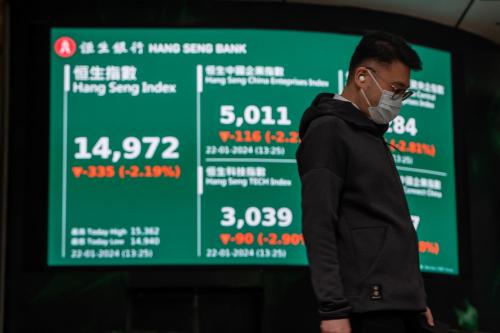Editor’s note: This commentary is based on research and analysis from the April 2015 update of Tracking Indexes for the Global Economic Recovery (TIGER) interactive map, which appears on the Financial Times Web site.
A stop and go global recovery seems at risk of stalling again, with only isolated pockets of strength evident in the world economy. A modest reversal of fortunes between the advanced and emerging market economies belies the fact that both groups still face stunted growth prospects.
The latest update of TIGER (Brookings-FT Tracking Indexes for the Global Economic Recovery) reveals a somber picture characterized by stagnant low growth, risks of deflation, and weak consumer and business confidence. Barring three economies with sustained growth momentum—the U.S., U.K., and India—there are few others where short-term growth prospects look encouraging. Geopolitical uncertainties, ranging from the volatile negotiations between Greece and its euro zone counterparts to the tensions in Ukraine and the Middle East, continue to sap confidence.
The divergence in business cycle conditions between the U.S. and most other major advanced and emerging market economies remains pronounced. The euro zone and Japanese economies are showing signs of a mild revival, although a restoration of strong growth is not yet at hand, while most major emerging markets including China are facing a loss of growth momentum.
U.S. economic growth remains resilient, but slowing employment growth suggests that the persistent strength of the U.S. dollar and the burden of carrying the world economy on its shoulders might be weighing on the U.S. economy. Consumer confidence remains strong, boosting growth in retail sales, and credit growth has picked up. However, with wage and price pressures still well contained, the likelihood that the Federal Reserve will start raising interest rates early in the summer has receded.
In the Eurozone, the ECB’s quantitative easing operations have stoked a marked depreciation of the euro and offset concerns about the fallout from a disorderly resolution of the Greek debt crisis. This has fueled a rally in European equity markets, and sovereign bond yields in both the core and periphery (barring Greece) have fallen. In tandem with low oil prices, this has helped stave off recession, although growth remains mostly tepid or nonexistent outside Germany and Spain. Business confidence is weak and deflationary pressures are still a concern.
Japan’s economy is also experiencing a mild recovery after a brief recession, helped by a falling yen that has boosted export growth. However, consumer and business confidence remain subdued and retail sales are falling. Weak domestic demand and low oil prices continue to strain the credibility of the Bank of Japan’s inflation target, suggesting that further monetary policy easing might be in prospect.
Common themes among emerging market economies are slower GDP growth, declining consumer and business confidence, and weak export growth as external demand remains subdued and the falling euro and yen have reduced the competitiveness of emerging market exports. Capital flows to emerging markets have been hit by concerns about these economies’ exposure to dollar-denominated corporate debt, which makes them vulnerable to a hike in U.S. interest rates.
China’s economy is facing a broad slowdown—growth in industrial activity has slowed significantly, producer prices continue to fall, and various other indicators of economic activity indicate a loss of momentum. Still, the government has enough policy space to maintain growth at around 7 percent for the next couple of years. The government appears committed to financial market reforms, including full liberalization of interest rates and an explicit deposit insurance system. These and a broad swath of market-oriented reforms remain essential if China is to rebalance its economy to a more sustainable growth model that is less dependent on investment growth and to avoid stumbling on financial system vulnerabilities, including the high level of debt in the economy.
India remains a bright spot among the emerging market economies, although the pace of reforms and the durability of growth remain significant elements of concern. Low oil prices have been a boon for India—helping to keep down the import bill, the current account deficit, and the budget deficit—but rising food prices will constrain the Reserve Bank of India’s room to support growth. Economies such as Brazil, Russia, and Turkey continue to face a range of obstacles—economic mismanagement, political instability, an unfavorable external environment— that have weighed on their growth and rendered them vulnerable to external shocks.
The main theme for 2015 seems to be that things could be worse rather than that better days are ahead. The urgency of structural reforms seems to have dissipated, with many economies relying on loose monetary policy and weak exchange rates to prop up growth and counter deflationary pressures. In the absence of a strong revival of domestic demand supported by a more balanced set of policies, a robust and sustained global economic recovery will remain elusive.
Prasad is a professor in the Dyson School at Cornell University, a senior fellow at the Brookings Institution, and author of “The Dollar Trap”. Foda is a research associate at Brookings. Sahu is a student at Cornell.



Commentary
Op-edA Stop and Go Recovery is in Danger of Another Stall
April 12, 2015